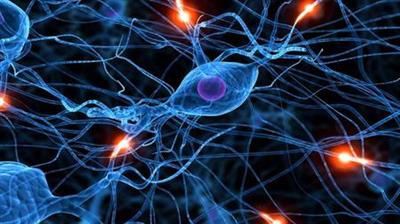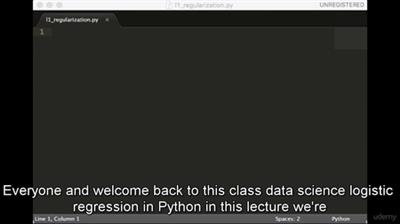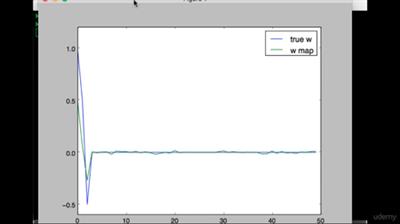Udemy - Deep Learning Prerequisites: Logistic Regression in Python
WEBRip | English | MP4 | 1280 x 720 | AVC ~78 kbps | 10 fps
AAC | 192 Kbps | 48.0 KHz | 2 channels | Subs: English (.srt) | ~6 hours | 1.25 GB
Genre: eLearning Video / Development, Data Science, Deep Learning
Data science techniques for professionals and students - learn the theory behind logistic regression and code in Python
What you'll learn
program logistic regression from scratch in Python
describe how logistic regression is useful in data science
derive the error and update rule for logistic regression
understand how logistic regression works as an analogy for the biological neuron
use logistic regression to solve real-world business problems like predicting user actions from e-commerce data and facial expression recognition
understand why regularization is used in machine learning
Requirements
Derivatives, matrix arithmetic, probability
You should know some basic Python coding with the Numpy Stack
Description
This course is a lead-in to deep learning and neural networks - it covers a popular and fundamental technique used in machine learning, data science and statistics: logistic regression. We cover the theory from the ground up: derivation of the solution, and applications to real-world problems. We show you how one might code their own logistic regression module in Python.
This course does not require any external materials. Everything needed (Python, and some Python libraries) can be obtained for free.
This course provides you with many practical examples so that you can really see how deep learning can be used on anything. Throughout the course, we'll do a course project, which will show you how to predict user actions on a website given user data like whether or not that user is on a mobile device, the number of products they viewed, how long they stayed on your site, whether or not they are a returning visitor, and what time of day they visited.
Another project at the end of the course shows you how you can use deep learning for facial expression recognition. Imagine being able to predict someone's emotions just based on a picture!
If you are a programmer and you want to enhance your coding abilities by learning about data science, then this course is for you. If you have a technical or mathematical background, and you want use your skills to make data-driven decisions and optimize your business using scientific principles, then this course is for you.
This course focuses on "how to build and understand", not just "how to use". Anyone can learn to use an API in 15 minutes after reading some documentation. It's not about "remembering facts", it's about "seeing for yourself" via experimentation. It will teach you how to visualize what's happening in the model internally. If you want more than just a superficial look at machine learning models, this course is for you.
Suggested Prerequisites:
calculus (taking derivatives)
matrix arithmetic
probability
Python coding: if/else, loops, lists, dicts, sets
Numpy coding: matrix and vector operations, loading a CSV file
TIPS (for getting through the course):
Watch it at 2x.
Take handwritten notes. This will drastically increase your ability to retain the information.
Write down the equations. If you don't, I guarantee it will just look like gibberish.
Ask lots of questions on the discussion board. The more the better!
Realize that most exercises will take you days or weeks to complete.
Write code yourself, don't just sit there and look at my code.
WHAT ORDER SHOULD I TAKE YOUR COURSES IN?:
Check out the lecture "What order should I take your courses in?" (available in the Appendix of any of my courses, including the free Numpy course)
Who this course is for:
Adult learners who want to get into the field of data science and big data
Students who are thinking of pursuing machine learning or data science
Students who are tired of boring traditional statistics and prewritten functions in R, and want to learn how things really work by implementing them in Python
People who know some machine learning but want to be able to relate it to artificial intelligence
People who are interested in bridging the gap between computational neuroscience and machine learning
General
Complete name : 6. L1 Regularization - Code.mp4
Format : MPEG-4
Format profile : Base Media / Version 2
Codec ID : mp42 (isom/iso2/avc1/mp41/mp42)
File size : 12.0 MiB
Duration : 6 min 13 s
Overall bit rate : 270 kb/s
Encoded date : UTC 2016-12-13 07:57:54
Tagged date : UTC 2016-12-13 07:57:54
Writing application : Lavf53.32.100
Video
ID : 1
Format : AVC
Format/Info : Advanced Video Codec
Format profile : High@L3
Format settings : CABAC / 4 Ref Frames
Format settings, CABAC : Yes
Format settings, RefFrames : 4 frames
Codec ID : avc1
Codec ID/Info : Advanced Video Coding
Duration : 6 min 13 s
Bit rate : 78.0 kb/s
Width : 1 280 pixels
Height : 720 pixels
Display aspect ratio : 16:9
Frame rate mode : Constant
Frame rate : 10.000 FPS
Color space : YUV
Chroma subsampling : 4:2:0
Bit depth : 8 bits
Scan type : Progressive
Bits/(Pixel*Frame) : 0.008
Stream size : 3.48 MiB (29%)
Writing library : x264 core 136
Encoding settings : cabac=1 / ref=4 / deblock=1:0:0 / analyse=0x3:0x113 / me=umh / subme=7 / psy=0 / mixed_ref=1 / me_range=16 / chroma_me=1 / trellis=1 / 8x8dct=1 / cqm=0 / deadzone=21,11 / fast_pskip=0 / chroma_qp_offset=0 / threads=48 / lookahead_threads=5 / sliced_threads=0 / nr=0 / decimate=1 / interlaced=0 / bluray_compat=0 / constrained_intra=0 / bframes=16 / b_pyramid=2 / b_adapt=1 / b_bias=0 / direct=1 / weightb=1 / open_gop=0 / weightp=2 / keyint=300 / keyint_min=25 / scenecut=40 / intra_refresh=0 / rc=2pass / mbtree=0 / bitrate=78 / ratetol=1.0 / qcomp=0.60 / qpmin=10 / qpmax=51 / qpstep=4 / cplxblur=20.0 / qblur=0.5 / ip_ratio=1.40 / pb_ratio=1.30 / aq=1:1.00
Encoded date : UTC 2016-12-13 07:57:54
Tagged date : UTC 2016-12-14 02:55:01
Audio
ID : 2
Format : AAC
Format/Info : Advanced Audio Codec
Format profile : LC
Codec ID : mp4a-40-2
Duration : 6 min 13 s
Bit rate mode : Constant
Bit rate : 192 kb/s
Channel(s) : 2 channels
Channel positions : Front: L R
Sampling rate : 48.0 kHz
Frame rate : 46.875 FPS (1024 SPF)
Compression mode : Lossy
Stream size : 8.44 MiB (70%)
Default : Yes
Alternate group : 1
Encoded date : UTC 2016-12-13 07:57:54
Tagged date : UTC 2016-12-14 02:55:01
Screenshots
Download link:Kod:rapidgator_net: https://rapidgator.net/file/06636bd09efa923abacaf7c7dd841a19/hby5e.Udemy..Deep.Learning.Prerequisites.Logistic.Regression.in.Python.Updated.part1.rar.html https://rapidgator.net/file/62ddd6ab80eb03b37b0e1246eb530c40/hby5e.Udemy..Deep.Learning.Prerequisites.Logistic.Regression.in.Python.Updated.part2.rar.html https://rapidgator.net/file/c29a211212c5a270406e6ac259ebd353/hby5e.Udemy..Deep.Learning.Prerequisites.Logistic.Regression.in.Python.Updated.part3.rar.html nitroflare_com: https://nitroflare.com/view/933FDC0C504A751/hby5e.Udemy..Deep.Learning.Prerequisites.Logistic.Regression.in.Python.Updated.part1.rar https://nitroflare.com/view/7345ACB680416A7/hby5e.Udemy..Deep.Learning.Prerequisites.Logistic.Regression.in.Python.Updated.part2.rar https://nitroflare.com/view/CB99C0431A390E4/hby5e.Udemy..Deep.Learning.Prerequisites.Logistic.Regression.in.Python.Updated.part3.rarLinks are Interchangeable - No Password - Single Extraction
1 sonuçtan 1 ile 1 arası
-
29.04.2020 #1Üye



- Üyelik tarihi
- 20.08.2016
- Mesajlar
- 147.735
- Konular
- 0
- Bölümü
- Bilgisayar
- Cinsiyet
- Kadın
- Tecrübe Puanı
- 156
Udemy - Deep Learning Prerequisites Logistic Regression in Python (Updated)
Konu Bilgileri
Users Browsing this Thread
Şu an 1 kullanıcı var. (0 üye ve 1 konuk)



 LinkBack URL
LinkBack URL About LinkBacks
About LinkBacks







 Alıntı
Alıntı
Konuyu Favori Sayfanıza Ekleyin